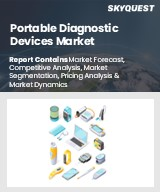
휴대용 진단 기기 세계 시장 규모는 2023년에 650억 달러로 평가되었습니다. 예측 기간(2025-2032년) CAGR 7.8%로, 2024년 700억 7,000만 달러에서 2032년에는 1,277억 9,000만 달러로 성장할 전망입니다.
세계 휴대용 진단 기기 시장은 소비자 행동의 변화, 정부의 이니셔티브, 기술 발전으로 인해 크게 성장하고 있습니다. 세계 각국 정부는 스마트 헬스케어 및 공중보건 이니셔티브를 지원하기 위해 의료 인프라를 강화하고 휴대용 진단 기술을 통합하는 것을 우선순위로 삼고 있습니다. 이 업계에서는 특히 머신러닝과 인공지능을 도입한 괄목할 만한 기술 혁신이 이루어지고 있으며, 이를 통해 건강정보의 보급을 획기적으로 변화시켜 환자 데이터, 바이오마커, 환경적 요인 분석을 통해 정확한 실시간 진단이 가능해졌습니다. 또한, 5G 네트워크와 같은 고급 연결 옵션의 배포는 원격 환자 모니터링을 강화하고 진단의 정확성과 효율성을 향상시킬 수 있습니다. 에너지 효율이 높은 자가발전 장비는 운영 비용과 환경에 미치는 영향을 최소화함으로써 헬스케어의 지속가능성을 촉진하고 있습니다.
Global Portable Diagnostic Devices Market size was valued at USD 65.0 billion in 2023 and is poised to grow from USD 70.07 billion in 2024 to USD 127.79 billion by 2032, growing at a CAGR of 7.8% during the forecast period (2025-2032).
The global portable diagnostic devices market is experiencing significant growth driven by shifts in consumer behavior, government initiatives, and advancements in technology. Various governments worldwide are prioritizing the enhancement of healthcare infrastructure and the integration of portable diagnostic technologies to support smart healthcare and public health initiatives. The industry has seen notable innovations, particularly with the incorporation of machine learning and artificial intelligence, which have transformed the dissemination of health information and enabled precise, real-time diagnostics through the analysis of patient data, biomarkers, and environmental factors. Additionally, the rollout of advanced connectivity options like 5G networks enhances remote patient monitoring, improving the accuracy and efficiency of diagnostics. Energy-efficient and self-powered devices are also promoting sustainability in healthcare by minimizing operational costs and environmental impact.
Top-down and bottom-up approaches were used to estimate and validate the size of the Global Portable Diagnostic Devices market and to estimate the size of various other dependent submarkets. The research methodology used to estimate the market size includes the following details: The key players in the market were identified through secondary research, and their market shares in the respective regions were determined through primary and secondary research. This entire procedure includes the study of the annual and financial reports of the top market players and extensive interviews for key insights from industry leaders such as CEOs, VPs, directors, and marketing executives. All percentage shares split, and breakdowns were determined using secondary sources and verified through Primary sources. All possible parameters that affect the markets covered in this research study have been accounted for, viewed in extensive detail, verified through primary research, and analyzed to get the final quantitative and qualitative data.
Global Portable Diagnostic Devices Market Segments Analysis
Global Portable Diagnostic Devices Market is segmented by Product, Technology, Application, End User and region. Based on Product, the market is segmented into Blood Glucose Meters, Pulse Oximeters, ECG Devices, Blood Pressure Monitors and Others. Based on Technology, the market is segmented into Point-of-Care Testing (POCT) and Home-Based Testing. Based on Application, the market is segmented into Infectious Diseases, Cardiovascular Diseases, Diabetes and Others. Based on End User, the market is segmented into Hospitals & Clinics, Diagnostic Centers, Homecare Settings and Others. Based on region, the market is segmented into North America, Europe, Asia Pacific, Latin America and Middle East & Africa.
Driver of the Global Portable Diagnostic Devices Market
The global market for portable diagnostic devices is experiencing significant growth, driven by swift advancements in technology such as enhanced sensors, improved connectivity through the Internet of Things (IoT), and the miniaturization of devices. These innovations facilitate the development of diagnostic tools that are not only more accurate but also user-friendly and capable of delivering faster results, which in turn boosts both advertiser confidence and patient uptake. Devices like portable ECGs and continuous glucose monitors offer real-time health data, thereby enhancing patient engagement and enabling better management of chronic diseases, further propelling the expansion of the portable diagnostic devices market.
Restraints in the Global Portable Diagnostic Devices Market
The steep initial investment required for advanced portable diagnostic devices poses a notable challenge to market expansion. The costs associated with cutting-edge hardware and software can deter adoption, particularly among individuals in developing nations or within healthcare systems constrained by limited budgets. This high price point tends to hinder the growth of the portable diagnostic devices market segment featuring premium products, as numerous potential users and smaller healthcare facilities may choose to utilize more conventional and affordable diagnostic alternatives instead. Consequently, such financial barriers can significantly impact the overall acceptance and market penetration of these innovative technologies.
Market Trends of the Global Portable Diagnostic Devices Market
The Global Portable Diagnostic Devices market is witnessing a transformative trend characterized by the integration of artificial intelligence and real-time data analytics into its offerings. This advancement enhances the capability of portable diagnostic devices to analyze patient data, identify health trends, and alert users or clinicians to potential health issues proactively. As a result, smarter predictive health monitoring systems are emerging, enabling more effective management of chronic diseases and fostering personalized medicine frameworks. This trend not only aims to optimize patient outcomes but also boosts the adoption of connected health solutions, indicating a robust shift towards more efficient and responsive healthcare delivery systems.